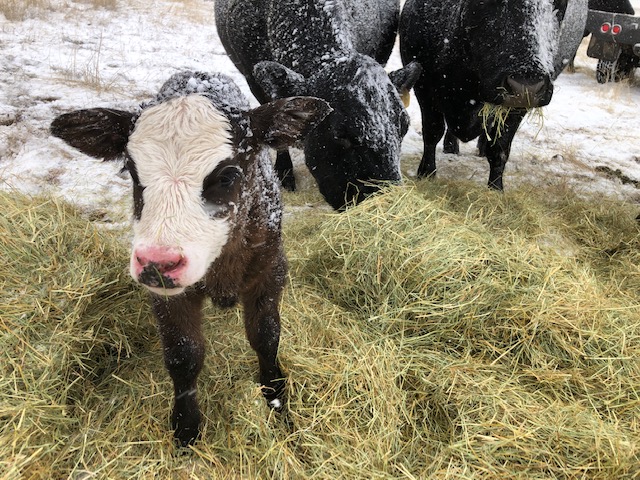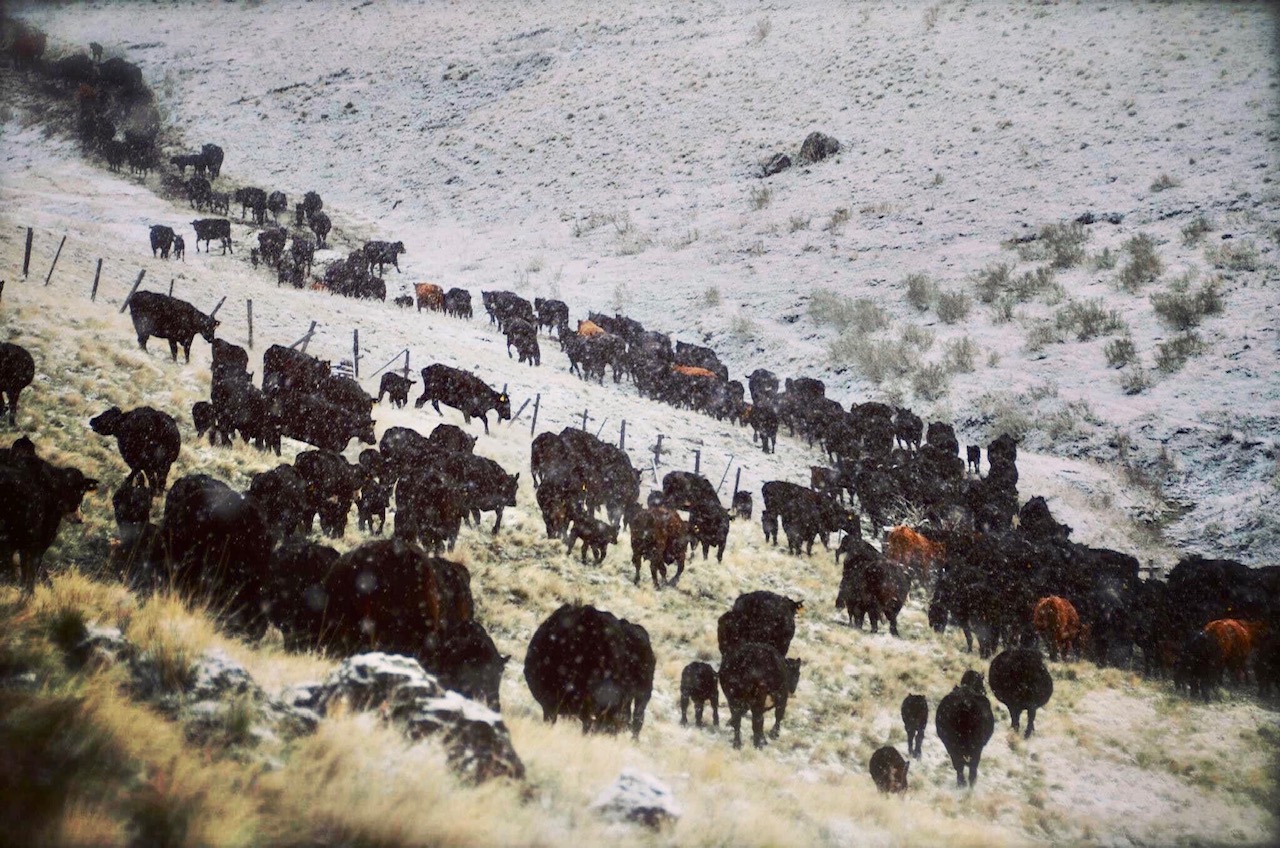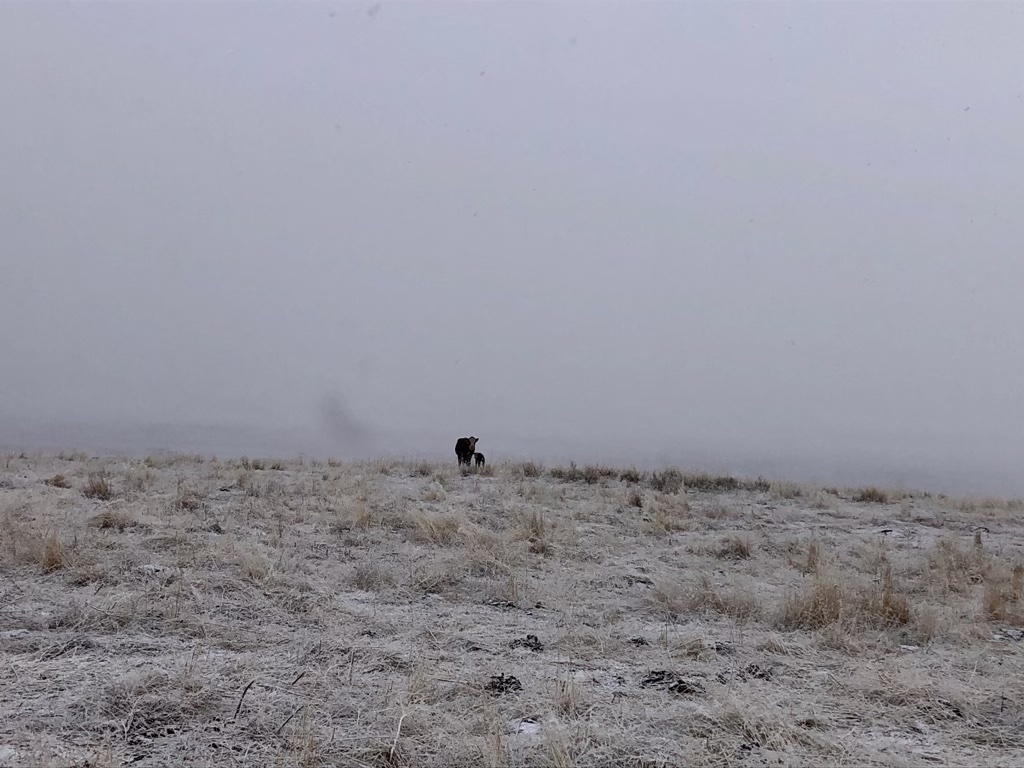
Relentless wintry weather means tragedy for many cattle ranches across the West
Listen
During spring’s prime calving season, lots of newborn calves have been dying from the cold. NWPB’s Anna King reports. (Runtime 4:10)
Read
In a remote part of southeast Oregon, about the only oasis for a hundred-mile stretch of highway is the Oasis Cafe in Juntura. Travelers come in for hot coffee served in hulking styrofoam cups, and to gather near the wood stove.
Rancher Glenn Harris, from Drewsy, said this spring’s bitter cold has been devastating for newborn calves.
“We had probably about two feet of snow, at least, on top of five or six inches of ice,” Harris said, referring to a storm last month. “Those calves are born and they just melt right down to that ice. And if you’re not right there, you’re gonna lose ‘em.”
Usually, the mother gives birth on her own without human help, and licks the newborn dry. But blizzards make things more complicated: the calves can go from about 100 degrees in the womb to zero – or minus several degrees with wind – and wet coats. Not to mention the more typical risks, like when the calf is too big for the mother’s frame, or the baby is breech.
Harris has a herd of mostly red angus. This year, he said he’s lost around 35 calves. About 25 have been injured from frozen joints.
“I mean they can barely walk,” Harris said. “It’s just been a really tough year.”

A herd moves slowly with their new calves in snowy conditions in April in Wallowa County, Oregon. (Credit: Angie Nash)
Tired shovels
We spoke with more than a dozen ranchers for this story, as well as an official from the U.S. Department of Agriculture (USDA), two weather experts and a cattle futures broker. The losses from the cold appear to be widespread.
On some ranches in southeast Oregon, the losses have been particularly staggering. Several ranchers estimated that they’ve lost a quarter of their calves to the cold. There’s no way of knowing the exact number – the USDA’s National Agricultural Statistics Service doesn’t count cattle during the spring – but all told, operators believe thousands of calves may have perished across the Northwest, West, and Midwest.
In Oregon last month, temperatures were below average nearly every day. The weather experts – Mary Wister, a meteorologist at the National Weather Service station in Pendleton, and Karin Bumbaco, a researcher with the University of Washington’s Climate Impacts Group – said atmospheric rivers blasting from parts of the Northwest through to the Midwest are partly to blame.
For ranchers, some losses are inevitable – but it’s extremely rare to have so many weather-related deaths.
Linda Owens has a cow-calf operation in McAllister, Montana.
“I’ve worn a shovel out this year digging myself out – my tractor, my pickup with the trailer […] trying to go out and get carcasses off the landscape,” Owens said. “I’ve shoveled more this year than I have for seven years for anything, and my shovel is very tired and I’m going to have to get a new one.”
A lot of the carcasses in Owens’ county go to an animal compost site. There are only two of them in the county, and Owens runs one of them. The other site is full, she said.
In addition to calves, Owens has also picked up several horses who slipped on ice and had to be put down, including one particularly sad case in February.
“He slipped on the ice and broke his leg,” she said. “It was right close in town and so the neighbor saw the horse out there.”
Saving every calf they can
A little further east in Kimball, South Dakota, Colby Olson was feeding his cattle in the snow. He said with hundreds of animals, they wouldn’t all fit in the barn during a bad storm.
Olson said his young children – ages eight, seven and even a three-year-old – have been pitching in by helping him match calves to the right mother.
“The kids, they called off school,” Olson said. “So I was picking up calves and throwing them in the back seat of the pickup. And I’d say, ‘Okay, put a scarf on that calf and remember he’s number 707.’”
Olson and other ranchers say they’re bringing newborn calves inside to blow them dry with hair dryers and get their ears warmed up. Ears and tails are the first to get frostbitten on young calves.

Mother cows tend to seek out privacy in a remote location to calve so the newborns aren’t stepped on by the rest of the herd. But with weather so tough, many ranchers have to keep the cows and first-time heifers close. (Credit: Angie Nash)
Low feed
In some of the areas facing persistent ice and snow, hay supplies were low due to widespread drought last year. Now, with increased demand, lots of ranchers are completely running out of feed. They can buy more, but trucking it in from far away or from out-of-state is expensive. And in some areas, they’ve already been feeding hay since November or December. By now, ranchers typically expect the grass to return in lower elevations. But with snow still covering much of the West’s rangeland, there’s little grass to turn cattle out on.
Some Oregon ranchers estimate it will be mid-May, way later than normal, before they’ll be able to turn out.
The only potential bright spot: when all the snow melts, they’ll have lots of moisture, which means good grass for grazing.
With his back to the wood stove at the Oasis Cafe in Juntura, Ore., rancher Glenn Harris’ eyes collected water at the rims. The wear of this icy spring showed on his face.
“It’s a struggle,” Harris said. “I had to put one down the other day that we tried for quite a while to save. And he really wanted to live. But he just kept getting weaker and weaker […] and [I] tubed him. And, anyway, he didn’t make it.”
He trailed off. Then, in a low voice, he said he’ll do the best he can with the calves he has left.















